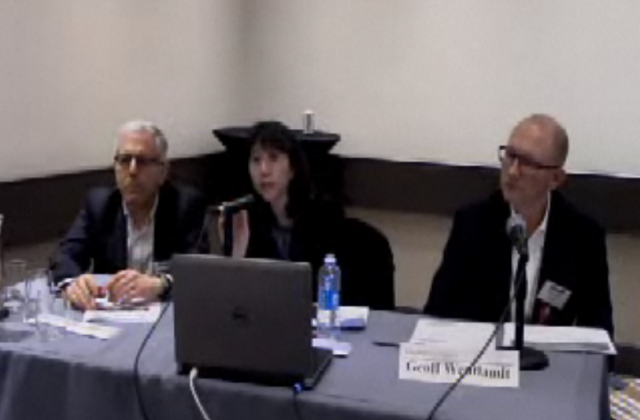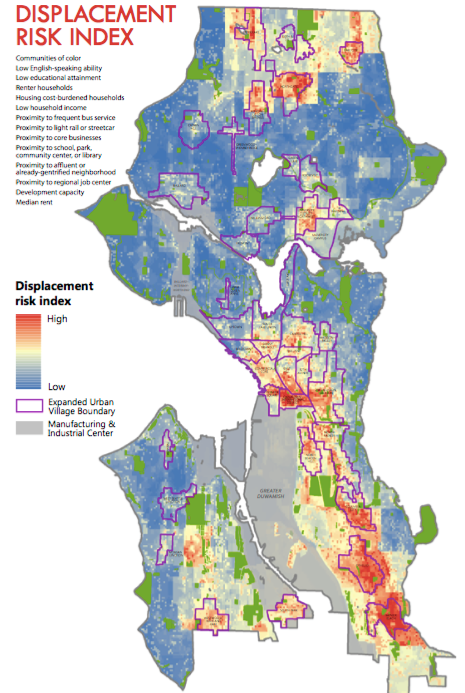The Problem With the Term “Displacement”
I have a post up at Forbes that lays out and refines a bit my concerns about the term, “Displacement.”
Unless and until there is a quantitative definition and measurement of displacement we ought to stop using the term. Compassion? Absolutely. Many people in our local economy are suffering. In fact, tonight, thousands of people within close distance to where I am writing this will sleep in cars, tents, or in doorways. The stubborn resistance to the simple fact of supply and demand and the argument that building new housing displaces people is slowing production by promoting policies that further restrict new housing. That is harmful to poor people. What is also harmful is the blithe disregard by people who ought to know better that taking the term seriously in the name of “acknowledging the problem” is certainly not adding to the discussion or making life better for anyone.
“Displacement” has been a hot topic lately, even inspiring an amendment to the Mandatory Inclusionary Zoning (MIZ) proposal to charge more fees for new housing in areas “at-risk” of displacement, even though there really isn’t any definition or measurement of it retrospectively. Like it or not, the term is going to continue to influence the housing discussion in the months ahead even though nobody really knows what it means or how to measure it.
Chaotic Council Meeting Includes Low Key Passage of Mandatory Inclusionary Zoning
Members of the Seattle City Council sat motionless for about two hours yesterday while they were bombarded by an overflow crowd demanding that the City not build a new $160 million dollar precinct building in north Seattle. After completely losing control of the meeting on more than one occasion, Council President Bruce Harrell shut the meeting down. After the meeting reconvened, the shouting, yelling, and hectoring by opponents of the precinct resumed. Interestingly, most of these people are great allies of the Council on minimum wage legislation, controlling how private employers schedule their employees, and on Mandatory Inclusionary Zoning (MIZ). Somewhere between the boisterous crowd’s protests and the Council voting 7 to 1 to build the precinct anyway, the Council passed the Framework of MIZ.
I’ve been watching the Council for 20 years now, and I’ve seen it debate a lot of issues. But the last few years have seen Council meetings flail about and get shouted down by angry lefty groups. What’s so odd about yesterday’s meeting is that these angry people opposed to the precinct (I don’t think it’s a good idea either at this point and I’d have voted “no” if I was on the Council) are the very ones pushing terrible housing policies like MIZ and rent control. The Council can’t seem to meet their whims fast enough on those things, yet on an issue with such a huge price tag and opposed by so many, the Council sort of waved it through. Strange.
It’s worth scanning through the first part of the video.
Also strange is that Councilmember Rob Johnson spent less than 5 minutes addressing the passage of the legislation. He pointed out that some people had concerns (i.e. making sure housing built with in lieu fees is near the project paying for it and extending rent restrictions from 50 to 75 years) and those concerns had been addressed with amendments. Councilmember Herbold hailed the fact that now there is a way to offset displacement caused by new development (something that is not really happening) and that her amendment will somehow help poor people. It won’t.
It was irritating to see the Councilmembers and press parroting the line about the passage of legislation “historic” because for the “first time ever” developers will have to include affordable housing in their projects. Not true. The Multifamily Tax Exemption (MFTE) Program requires performance at a higher rate that MIZ would and it creates more rent restricted housing more effectively.
At no point did any Councilmember acknowledge or refute any of the points we’ve made about the inflationary nature of MIZ (adding costs will boost overall prices) or those of neighborhood groups who are already opposed to more housing in their back yards or even down the street. It’s mystifying what political calculus, if any, is at work on the Second Floor of City Hall. The Council today set up the newspaper and gasoline to ignite inflation in the housing economy and angered Black Lives Matters and many other progressives. All I can say is, “I don’t get it.”
Our next steps will be to get prepared for the many battles over the various zones that the Council will have to upzone in order to wring fees and units out of new development. That’s not likely to happen until next year.
More MIZ: SEPA Problems and a Rift Between City Staff and HALA Co-Chairs
When legislation is about to pass things can get interesting. As I pointed out in a previous posts more problems have emerged with legislation being considered today by the Council to pass the Framework for the Mandatory Inclusionary Zoning (MIZ) program. The issue is whether SEPA has been done properly or whether the City is trying to break up the process so that it can avoid doing a full Environmental Impact Statement (EIS) for the whole Grand Bargain. I think they are being clever. But it really doesn’t matter what I think, only a judge could make that determination.
Oddly, the only response to my e-mail came from Faith Pettis, Co-Chair of the Mayor’s Housing Affordability and Livability Agenda (HALA) Committee. Pettis, a attorney with the Pacifica Law Group a firm that specializes in housing finance, especially Low Income Housing Tax Credits (LIHTC), protested my characterization of her passive agreement with City staff about whether MIZ is inflationary.
Pettis apparently DOESN’T agree with the staff writing the value exchange part of MIZ. What’s odd about that is she could have said so, on the spot while the camera was rolling. She didn’t. I figured that meant she agreed. She also refused to be on a panel with me on it, a panel where we could have had this debate. Anyway, here are the e-mails — no Russians were involved.
Unfortunately, due to a peculiarity with my email set up I don’t have my response to Pettis’ response which was essentially to affirm what I wrote and to urge anyone interested to watch the video themselves. I didn’t make the point that when sitting right next to Geoff Wentlandt Pettis didn’t disagree with what Wentlandt said.
In the end, as I pointed out on Publicola, this Council will grind ahead today over all this falderal and pass the MIZ Framework 9 to nothing: getting yet another wrong thing done.
————————
Greetings Councilmembers,
I want to be sure that we are on public record expressing concerns about the passage of the so called Framework tomorrow (Council Bill 118736).
Roger–
Roger,
We want to set the record straight. Your statement, taken from your below email:
We have already expressed substantive disagreement: Mandatory Inclusionary Zoning (MIZ) is an inflationary policy that will only make housing prices worse for consumers by adding additional costs and slowing production with inclusion mandates and fees. The City and the Chairs of the HALA Committee have publicly agreed that this “a valid way to view the program.”
is flat out wrong. Neither of us made the statement you are attributing to us and furthermore neither of us agrees with your larger misconstruction of a supposed point. We request that you not misquote us or twist our statements to appear to serve your interests.
Faith Pettis and David Wertheimer
HALA Co-Chairs
Council to Pass MIZ Framework In Spite of New Legal Concerns
Later this morning, the Seattle City Council will take one step closer to imposing a full fledged Mandatory Inclusionary Zoning (MIZ) policy requiring fees or inclusion of price controlled housing units with all new construction. Along with the many arguments we’ve made against the proposal there is an additional one: the City Council is acting even though there has been a Determination of Significance (DS) through the State Environmental Policy Act (SEPA) process required of all legislation affecting land use. The read that the Council has taken on this is that the framework doesn’t make zoning changes itself only sets up a mechanism and it completed a SEPA process last year that had a Determination of Non Significance (DNS). The DS applies to zoning changes. But the question is, “What zoning changes?” None are proposed yet.
These fine grained legal arguments about whether the Council can actually vote while a DS has been issued on as of yet unwritten legislation created zoning changes under the framework in from of them won’t stop them from voting. It may be that a Judge will have to decide whether they acted too hastily on passage of the legislation or not. Neighborhood groups, especially those impacted by upzone proposals in the U District are expressing the most consternation. Builders and developers may join a legal challenge later if there is some possibility of slowing the whole MIZ process down by forcing the City to hold off until the Environmental Impact Statement (EIS) required when there is a DS is completed.
Meanwhile, the biggest threat to producers and consumers of housing of all kinds is the whole MIZ proposal itself becoming the tool of various political interests. I’ve posted a video by a local group called Speculation. If the MIZ proposal withstands various legal challenges and the Council grinds ahead, the video lays out what is most likely to happen. Social justice and neighborhood groups are going to put increasing pressure on the City Council to impose more fees and more inclusion mandates. The images in the video would make a credulous person think that the upzones associated with MIZ instead of being modest and incremental increases in zoning capacity are a change to Hong Kong style height and scale. That simply isn’t the case.
While the Council is very likely to align itself with the sentiments and misunderstandings in the video, making the proposal worse that it is even now, that might be a hopeful sign. The more and more requirements piled on will make a legal challenge even easier to make — and even more urgent. It’s too bad the Council can’t just make sound housing policy in the first place.
Herbold’s New Red Line: Why Make it Harder to Build in Poor Neighborhoods?
Councilmember Lisa Herbold’s amendment to the framework for Mandatory Inclusionary Zoning sends a bizarre signal to the housing market: don’t build housing in poor neighborhoods. We’ve already said over and over again that Mandatory Incentive Zoning (MIZ) adds costs and delays to the production of housing with fees and inclusion requirements. Those costs, imposed to create a few units of subsidized housing, will end up pushing up all other housing prices. And simply put, when you add fees or taxes to something, like smoking for example, it’s often because you want less of it. Think of my cap and trade analogy. But why would we want to make it hard to build in neighborhoods that have the following characteristics?
Communities of color
Low English-speaking ability
Low educational attainment
Renter households
Housing cost-burdened households
Low household income
Those are the measures used to develop what the City called its Displacement Risk Index. Other factors that are blended together to create the index are being too far or distant from
Frequent bus service
light rail or streetcar
Core businesses
School, park, community center, or library
An affluent or already gentrified neighborhood
A regional job center
Here’s a map showing in red where these “at risk” neighborhoods are:
What Herbold’s amendment does if implemented will be to raise barriers for new housing construction in these very places that would benefit from it the most in the name of preserving existing low price housing. But think about that for a second. By making it more expensive to build in these areas developers will naturally avoid them. After all, the rents are lower there and returns will be harder to make, especially with MIZ fees and Herbold’s add on for being “at risk.”
While this might stop building cold in these neighborhoods, it also will stop other investments in infrastructure and businesses. But when housing demand does start finding it’s way to these places, and housing production does begin, it’s going to be even more expensive to pay for the fees or inclusion. So in the very places that would benefit most from new investment in housing and all the goods that come with it, we’re discouraging development; when that development does happen it will be very expensive housing.
Nothing makes sense about MIZ, raising housing prices in the name of affordability, nor does this Displacement Index Penalty (let’s call it DIP for short). All DIP does is delay more of a good thing in these neighborhoods in the name of keeping people in place but in places that are by the City’s definition, bad places. And we already know that displacement isn’t happening anyway or certainly not the way that it has been talked about. I’ll post this chart again to make that point.
What Herbold’s amendment does is draw a new red line around poorer neighborhoods and puts a “Keep Out” sign in front of them. It yet more well intentioned but horrible housing policy that will make life worse for the people its intended to help.






